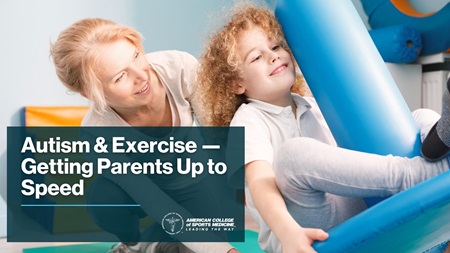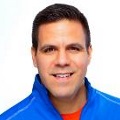David Geslak, ACSM-EP |
April
8, 2022
 “My child is no longer involved in occupational therapy or physical therapy, so he’s not moving as much. What should I do … ?”
“My child is no longer involved in occupational therapy or physical therapy, so he’s not moving as much. What should I do … ?”
This is a conversation I have had many times over the last 18 years. Parents call my organization, Exercise Connection, in their search to find a logical next step. What they are surprised to learn is that the benefits of exercise go beyond health for someone on the autism spectrum.
Occupational therapy (OT) and physical therapy (PT) are part of the early intervention plan when a child is diagnosed with autism, and these services typically continue as the child progresses through school. While OT and PT focus on a variety of functional skills and are therapies that involve gross-motor movement, they don’t meet the child’s daily physical activity requirements. Even though physical education is mandated in schools in the United States (which many parents aren’t aware of, BTW), many children with disabilities are not receiving it. These services end when their child achieves their goal or ages out of school, leaving parents wondering what’s next.
Many parents conclude that it’s exercise. As fitness professionals, we have an opportunity to fill this gap for the autism community and simultaneously expand our customer base. If you embark on this mission, you will not only get tremendous satisfaction but will gain an audience that really needs in-person training. Autism is the world’s fastest growing developmental disability and can no longer be ignored. Inclusion is a worldwide topic and should include fitness centers and gyms. When those with autism come into your gym, you need to be prepared to teach them. To do so, you’ll also need to understand their parents.
Sales approach vs. sales empathy
Before I found my mission (or the mission found me) of teaching exercise to persons with autism, I spent time in a big box gym as a personal trainer. They hired me for my experience in working with children. I went through their sales training because my boss wanted to show me “how it’s done.” He was using the same sales approach as if he was talking to a middle-aged, overweight man who was wavering on committing to 10 personal training sessions. As you might have guessed, it was a complete disconnect for the parents. As a result, the gym wasn’t “closing the sale,” but rather closing the door on children who were almost there.
Engaging with this community requires a different understanding. Parents of those with autism have been sold false hope and “snake oil” for years. Most are frustrated, exhausted and just trying to get through the day. Fancy exercise physiology language won’t impress them. Instead, focus your eyes and attention on their child, asking questions to him/her (whether they can talk or not). Educate the parents about the benefits of exercise, and have the research on hand. Give them time (both the parent[s] and the child) to process the information, tour the facility and not be rushed. When done right, you will give parents hope that their child can reach their fullest potential. And they will sign up.
Be respectful — sell one session, not ten. The parent will appreciate the fact that your goal is to have their son or daughter want to return for their second session. If you do that, you will be building a foundation to have a client for life. That is the win.
Related content:
CEC Course | Autism Exercise Specialist
Blog | 3 Key Elements to Successfully Training Children with Autism
Video | Overview of Autism Webinar 1
 David S. Geslak, BS, ACSM-EP, the founder of Exercise Connection, has pioneered exercise tools and programs to engage and improve the lives of those with autism. David also created the Autism Exercise Specialist Certificate (AESC) in partnership with ACSM. He has trained professionals around the world on the AESC. His commitment and methodology to bringing exercise to persons with autism has been enthusiastically embraced by professionals, higher education, and the autism community.
David S. Geslak, BS, ACSM-EP, the founder of Exercise Connection, has pioneered exercise tools and programs to engage and improve the lives of those with autism. David also created the Autism Exercise Specialist Certificate (AESC) in partnership with ACSM. He has trained professionals around the world on the AESC. His commitment and methodology to bringing exercise to persons with autism has been enthusiastically embraced by professionals, higher education, and the autism community.